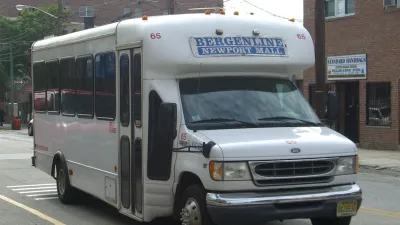The New Yorker has published an interactive feature in New York's shadow transit system—the network of so-called "dollar vans."
Aaron Reiss writes the article that accompanies an interactive feature about New York's "dollar vans, beginning with a brief history of their invention and proliferation, dating back to a transit strike in 1980.
"Today, dollar vans and other unofficial shuttles make up a thriving shadow transportation system that operates where subways and buses don’t—mostly in peripheral, low-income neighborhoods that contain large immigrant communities and lack robust public transit. The informal transportation networks fill that void with frequent departures and dependable schedules, but they lack service maps, posted timetables, and official stations or stops. There is no Web site or kiosk to help you navigate them. Instead, riders come to know these networks through conversations with friends and neighbors, or from happening upon the vans in the street."
The article consists of a series of interactive vignettes, focusing on each of the many "dollar van" lines—from a network connecting the various Chinatown communities around the city, to the Caribbean communities that power the network in Flatbush, and more. There are even several "dollar van" routes that cross the Hudson River into New Jersey via the George Washington Bridge and the Lincoln Tunnel.
[Editor's note: this article made the rounds this week on the social media discussion. It isn’t as current as submissions to the Planetizen news feed, but it was too compelling to pass up an opportunity to share. Enjoy.]
FULL STORY: New York's Shadow Transit

Trump Administration Could Effectively End Housing Voucher Program
Federal officials are eyeing major cuts to the Section 8 program that helps millions of low-income households pay rent.

Planetizen Federal Action Tracker
A weekly monitor of how Trump’s orders and actions are impacting planners and planning in America.

Ken Jennings Launches Transit Web Series
The Jeopardy champ wants you to ride public transit.

Crime Continues to Drop on Philly, San Francisco Transit Systems
SEPTA and BART both saw significant declines in violent crime in the first quarter of 2025.

How South LA Green Spaces Power Community Health and Hope
Green spaces like South L.A. Wetlands Park are helping South Los Angeles residents promote healthy lifestyles, build community, and advocate for improvements that reflect local needs in historically underserved neighborhoods.

Sacramento Plans ‘Quick-Build’ Road Safety Projects
The city wants to accelerate small-scale safety improvements that use low-cost equipment to make an impact at dangerous intersections.
Urban Design for Planners 1: Software Tools
This six-course series explores essential urban design concepts using open source software and equips planners with the tools they need to participate fully in the urban design process.
Planning for Universal Design
Learn the tools for implementing Universal Design in planning regulations.
Heyer Gruel & Associates PA
Ada County Highway District
Institute for Housing and Urban Development Studies (IHS)
City of Grandview
Harvard GSD Executive Education
Toledo-Lucas County Plan Commissions
Salt Lake City
NYU Wagner Graduate School of Public Service





























